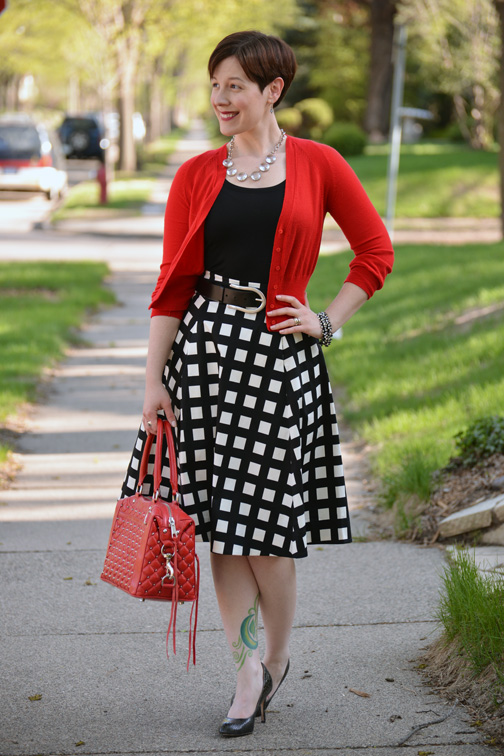Before I became interested in dressing and style, I avoided thinking about my body. At all costs. I didn't look in the mirror if I didn't have to, didn't focus much energy or attention on how my outfits interacted with my figure, and did my utmost to think about anything besides my own physicality. Because of this choice, the information I was given about my body came almost exclusively from external sources. And none of it was good news: I was chubby, disproportionate, my breasts were too small and my hips were too big, my arms were flabby and so was my stomach. Virtually all of this information was comparative: I was flabby compared to Gwyneth Paltrow, my breasts were too small compared to Victoria's Secret models ... you know the drill. I studiously ignored my body, hoping its perceived inadequacies would diminish if I pretended I was a brain in a jar. And yet this comparative information still crept in and made me feel inadequate.

I've struggled with anxiety for over a decade, but only recently learned something important about the power of my own fears: Like most people, I avoid the things that make me feel anxious and afraid. This avoidance brings temporary relief, which amounts to a reward response. And the longer this cycle continues, the more likely I am to avoid these anxiety-producing things and the more powerful their fear factors become. When I allow myself to consider and face the things that cause me to feel anxious -- generally with a "what's the worst that can happen?" attitude in tow -- I can diffuse some of their power over me. This is not to say that I've decided to immediately and aggressively confront every last one of my triggers. But it means that I now understand something essential about my body image struggles: I may have been making myself feel worse about my body by pretending it didn't exist. Because during those years of avoidance, I was occasionally forced to deal with and contemplate my body. And when I was forced to look at it, "evaluate" it, address it in some way, that experience became extremely loaded, difficult and well nigh-traumatic.
I know many women who, like me, spent years studiously ignoring their bodies before finally deciding to make a change. Some chose to begin the conversation though fitness or food. Some chose meditation or yoga. Some found motherhood to be an awakening into discussion with their physical forms. For reasons I didn't quite grasp at the time, I began to examine my body through the lens of clothing.
The world of fashion provides fertile ground for self-loathing. There are infinite messages about what women "can" and "cannot" wear based on their figures, beliefs about superior body sizes and shapes and bizarre hierarchies of beauty reinforced by the fashion machine. But instead of focusing on those things, I reached for the information that clothing offered to me about my body. It said, "Skirts won't constrict your hips or squeeze your midsection," and "Your small bust makes it possible for you to wear a huge variety of shirts." It said, "Belts draw the eye to your waist," and "Boots make you feel invincible." Instead of learning about my body through it's weight or size, its response to food or exercise, I learned about my body through its relationship to the clothing I chose to wear. I learned how it is shaped by experimenting with clothes, and I learned what felt good to wear and what felt like a struggle.
And I learned all of those things about my specific body. Not my body on a spectrum, not my body compared to an ideal body but instead my body in relative isolation. Although I certainly had my moments of cursing skinny jeans and feeling frustrated that they didn't look or feel "right" to me, I was mostly able to glean information about my body that felt fairly factual and scientific. I have broad hips and a small waist for my build. I have small breasts and wrists and ankles for my build. I have a high waistline and full upper arms for my build. It was all about me, and that made it feel less loaded.
Definitely an imperfect system for learning. After all, there was still comparison at play: Someone designed those clothes and made decisions about how big and small and proportioned they would be. And that someone was using those same beauty-body blueprints to guide their design decisions. Because I am privileged enough to fall somewhere within that socially-sanctioned spectrum, I was able to try on and contemplate a huge variety of styles and have them fit me. (More or less.) This is not possible for every woman, and for many there may be layers of implied judgment in that not-fitting that would make this approach far too painful to be beneficial.
But it worked for me and it might work for others. Depending on how you're wired, considering your figure in terms of how it works with and against clothes can feel more constructive and informative than considering your figure as it compares to BMI charts or the bodies of other women. "Too small for that dress" or "too tall for those pants" are informative and specific, and lack the stinging judgment of "too small" or "too tall" period. Your body is naked sometimes, and naked is its natural state. But you go about most of your life clothed, so learning about your body through dressing it can be both enlightening and beneficial.
As a person who loves and explores style, I understand my body now in ways I never did before. I don't fear it, I don't avoid it, and I feel like I can converse with it through dressing and clothing. And I'm much happier now that we're on speaking terms again.